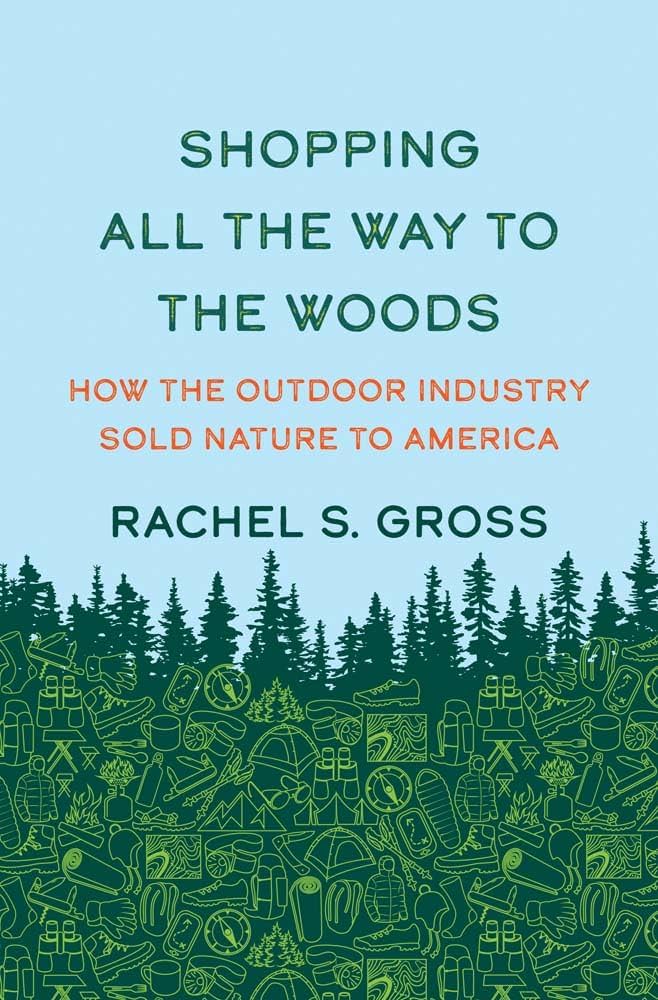I admit: I was shopping at outdoor retailers long before I started hiking. I started shopping at EMS in college in the late 90s because fleece vests were THE thing to be wearing at my small Northeastern school, and there was an EMS right in the local mall. The only outdoors that vest saw was my college campus as I walked to and from class.

As I started to get outside more and hike, I got nervous about “doing it right” so I headed over to an outdoor retailer and picked up some brand-name fleece, wool socks, and boots. When my son joined a nature class, I got him base layers and a rainsuit suit and boots. Not being entirely comfortable in these ventures, I felt like, well, if I get the clothes right, it’ll be okay, at least. And while there is an element of truth to that, to some extent the outdoor industry depends on that anxiety of “not fitting in” or the need to “Get It Right” to market a slew of clothing and items.
Rachel S. Gross tackles this in her new book Shopping All the Way to the Woods: How the Outdoor Industry Sold Nature to America. A historian of outdoor gear, she explores the meanings that Americans give to not just their outdoor experiences, but also to the gear they choose and use—and she does so in conjunction with closely associated topics like what is an “outdoors person” identity, what it’s meant throughout history, and who created it; how people form their identities through buying certain goods; and how an identity related to the outdoors is intertwined with ideals of masculinity, as well as the American national identity.
Gross begins Shopping All the Way to the Woods with an examination of what was considered “authentic” outdoor clothing in the 19th century, and how the same clothing—buckskin—was seen as “backward” when on an Indigenous person, but “authentic” and “necessary” when on a white person. Shifting to the early 20th century and the creation of outdoor stores, she then looks at how these stores helped to create and perpetuate ideals of outdoorsmen and women, and how they cemented outdoor clothing as a status symbol of the upper class.
There’s a section on the scientific part of the outdoor clothing industry, where Gross veers off into the military and its testing of clothing, and how various clothing and layering systems were created, which then leads into a chapter on military surplus and how this helped more people to get outside because of how inexpensive the gear was. While informative, this section at times felt out of step with the rest of the book.
For me, the most interesting part of Shopping All the Way to the Woods was the section on how communities form through brands, and people’s sense of belonging through brands and gear. However, much of this section was focused on the 1940s through the 1970s. The last few chapters of the book feel rushed, and not much attention is paid to the last 30 years, which I would argue is a main drawback of the book, especially with how much the outdoor industry has changed, becoming more diverse and accessible than ever before (though we still have a ways to go). Gross touches on this briefly in the epilogue, but it feels a bit like an afterthought.
Overall, Shopping All the Way to the Woods is a fascinating and entertaining book about the history of outdoor retailers and their place in the outdoor industry, as well as an exploration of the development of the “outdoors person” identity. While I would have loved for Gross to have done more examination of things like the development of accessible clothing for disabled outdoors people and how outdoor clothing has evolved as it’s become more mainstream, as well as more attention paid to women in the outdoors and our clothing, this is a unique look at the history of outdoor gear and clothing, and the larger symbolism of it all.
Jaime Herndon
Jaime Herndon is a science writer and editor who loves the national parks and enjoys introducing her son to hiking and being outdoors. She’s so thankful that homeschooling has been the catalyst for getting her outside more and one day hopes to hike the Appalachian Trail.




